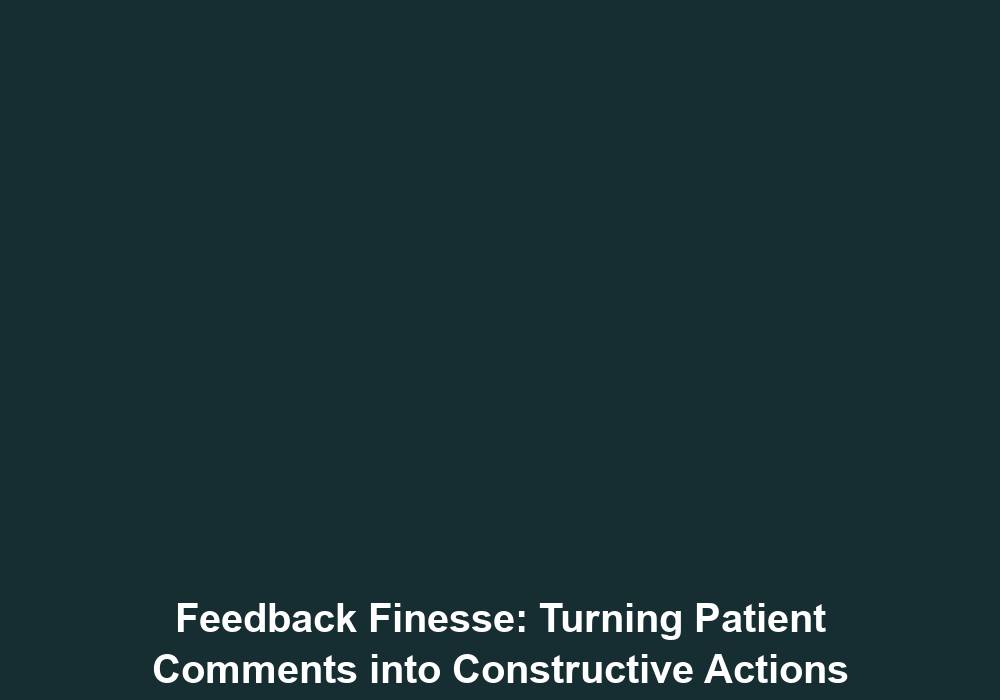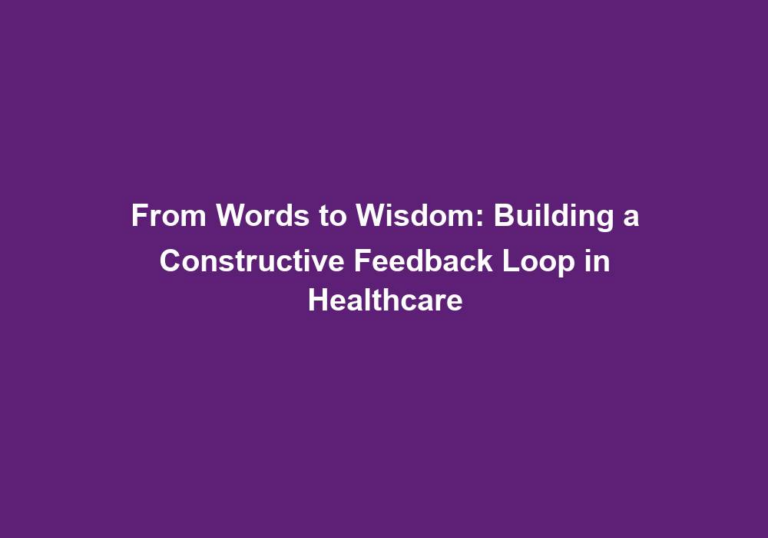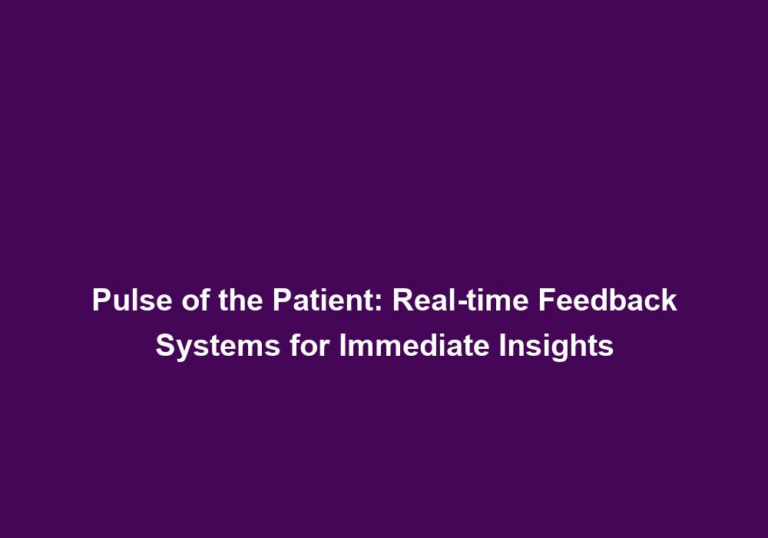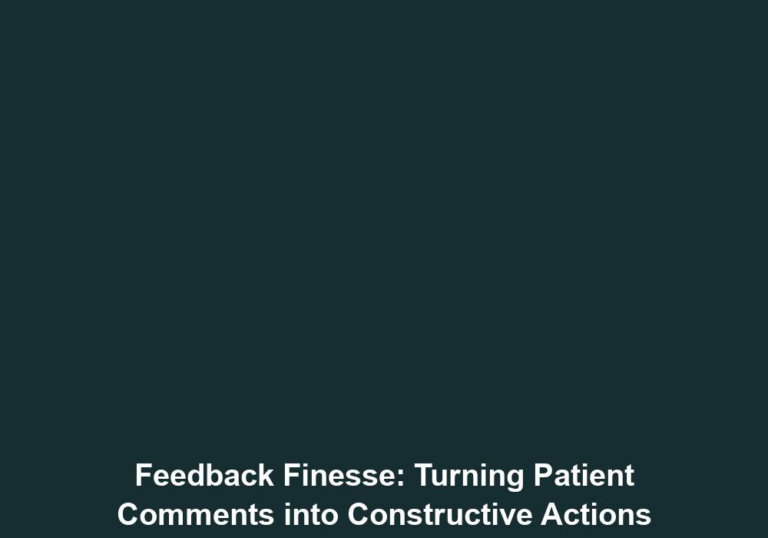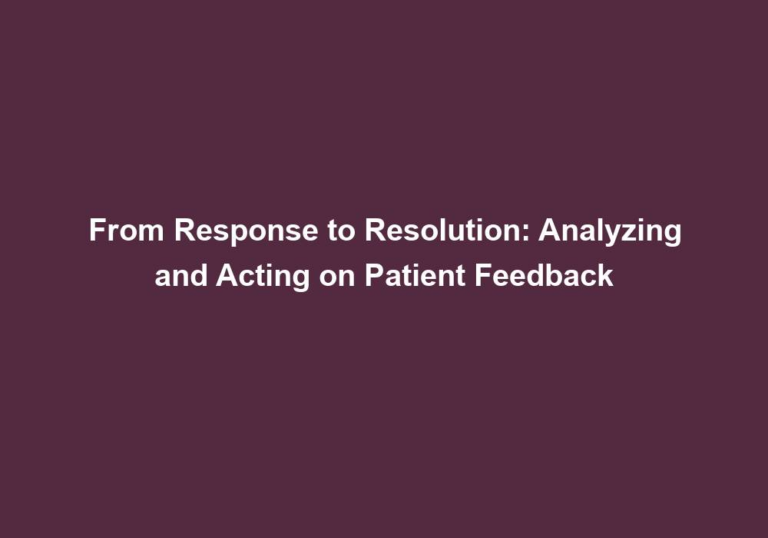Feedback Finesse: Turning Patient Comments into Constructive Actions
In the healthcare industry, patient feedback is a valuable resource for improving the quality of care and service delivery. Patient comments provide crucial insights that can help healthcare providers identify areas of improvement and make informed decisions to enhance the patient experience. In this article, we will explore how healthcare organizations can effectively use patient feedback and turn it into constructive actions.
The Importance of Patient Feedback
Patient feedback serves as a mirror, reflecting the strengths and weaknesses of a healthcare organization. It enables providers to understand the perspectives and experiences of their patients, giving them an opportunity to address any concerns and improve overall satisfaction levels. Here are a few reasons why patient feedback is vital:
-
Identifying Areas for Improvement: Patient comments can shed light on specific areas that require attention. Whether it’s long wait times, poor communication, or inadequate facilities, feedback helps pinpoint the key improvement areas.
-
Enhancing Patient Experience: By actively listening to patient feedback, healthcare organizations can tailor their services to meet patient expectations, resulting in a positive and satisfactory experience. For example, if multiple patients express dissatisfaction with long wait times, the organization can implement strategies to reduce waiting times, such as optimizing scheduling or improving workflow efficiency.
-
Building Trust: A feedback-driven approach demonstrates that healthcare providers value their patients’ opinions and are committed to continuous improvement. This fosters trust and strengthens the provider-patient relationship. When patients see that their feedback is being taken seriously and acted upon, they feel more confident and satisfied with the care they receive.
Collecting Patient Feedback
To effectively utilize patient feedback, healthcare organizations must establish efficient mechanisms for collecting and analyzing comments. Here are some effective methods for gathering patient feedback:
1. Surveys and Questionnaires
Surveys and questionnaires are widely used tools to collect feedback from patients. These can be distributed electronically, through email, or even in-person. The questions should be structured to address specific aspects of the patient experience, such as waiting times, staff behavior, and the overall quality of care. By using rating scales or open-ended questions, healthcare organizations can gather quantitative and qualitative feedback, respectively.
2. Online Feedback Platforms
In today’s digital era, online platforms provide a convenient way for patients to share their feedback. Healthcare organizations can create dedicated feedback portals or utilize existing review websites where patients can leave comments, ratings, and reviews. Monitoring these platforms allows providers to identify trends and respond promptly to patient concerns. It is important for organizations to actively engage with patients on these platforms by thanking them for their feedback, addressing any issues raised, and providing updates on actions taken.
3. Focus Groups and Interviews
Engaging patients in focus groups or conducting individual interviews can provide valuable qualitative insights. These methods allow for more in-depth discussions, and participants can express their opinions freely. Such interactions can help identify underlying issues and gather suggestions for improvement. In focus groups, patients can also interact with each other, leading to a better understanding of shared experiences and common concerns. Healthcare organizations should ensure that confidentiality is maintained during these discussions to encourage open and honest feedback.
4. Social Media Monitoring
Social media platforms are increasingly being used by patients to voice their opinions about healthcare experiences. Monitoring social media channels allows organizations to identify and address patient concerns promptly. Engaging with patients directly on these platforms demonstrates a commitment to excellent customer service. Healthcare organizations should actively respond to both positive and negative feedback, addressing concerns, providing clarifications, and expressing gratitude for positive reviews. By actively participating in social media conversations, healthcare organizations can build a positive online reputation and improve patient satisfaction.
Analyzing and Utilizing Patient Feedback
Collecting patient feedback is only the first step towards improvement. The real value lies in analyzing and utilizing this feedback to drive positive change within the organization. Here are some strategies for effectively analyzing and utilizing patient feedback:
1. Thorough Data Analysis
Reviewing and categorizing patient feedback is essential for understanding the common themes and identifying recurring issues. Analyzing quantitative data, such as survey results, helps pinpoint specific areas that require immediate attention. For example, if a large percentage of patients rate the cleanliness of the facilities as poor, the organization can focus on improving cleanliness standards and implementing regular maintenance routines. Additionally, qualitative data, such as comments and suggestions, provides deeper insights into patient experiences. These insights can be used to develop action plans and prioritize improvement initiatives.
2. Prioritize Actionable Feedback
While all feedback is valuable, it is essential to prioritize actionable feedback that can lead to feasible improvements. By focusing on the most critical issues, healthcare organizations can allocate resources effectively and address concerns that have the most significant impact on patient satisfaction. Prioritization can be based on factors such as the frequency of a particular issue, the severity of its impact on patients, and the organization’s capacity to address it. By addressing high-priority issues first, healthcare organizations can demonstrate their commitment to continuous improvement and enhance patient satisfaction.
3. Implementing Changes
Once the feedback has been analyzed and prioritized, it is crucial to take action promptly. This may involve making operational changes, enhancing staff training, or improving communication channels. For example, if patients consistently express dissatisfaction with the availability of appointment slots, the organization can explore options such as extended working hours, online appointment scheduling, or increasing the number of healthcare providers. Regularly monitoring the impact of these changes is essential to ensure the desired improvements are being achieved. Healthcare organizations should establish feedback loops to gather additional input from patients after implementing changes to evaluate their effectiveness and make further adjustments if necessary.
4. Communication and Transparency
Healthcare organizations must communicate with patients regarding the actions taken based on their feedback. This helps build trust and confidence, demonstrating that their opinions are valued. Regularly updating patients on the progress made and incorporating their suggestions further strengthens the provider-patient relationship. For example, if a patient highlighted a specific issue and the organization has taken steps to address it, they should be informed about the actions taken and the expected outcomes. Organizations can use various communication channels, such as email newsletters, social media posts, or dedicated feedback portals, to keep patients informed and engaged. By fostering transparent communication, healthcare organizations can build a culture of trust and collaboration with their patients.
Best Practices for Feedback Management
To ensure an effective feedback management system, healthcare organizations should consider implementing the following best practices:
-
Timely Response: Promptly acknowledge patient feedback and provide a timeline for resolving any concerns or issues. This demonstrates that the organization values patient input and is committed to addressing their needs.
-
Dedicated Feedback Team: Designate a team responsible for collecting, analyzing, and acting upon patient feedback to ensure accountability and consistency. This team should have clear roles and responsibilities, ensuring that feedback is not overlooked or delayed.
-
Staff Training: Educate healthcare providers and staff on the importance of patient feedback and how to handle it appropriately, emphasizing the need for a patient-centered approach. Training should cover active listening skills, empathy, and effective communication techniques.
-
Anonymous Feedback Option: Provide patients with the option to provide feedback anonymously to encourage honest and unbiased opinions. This can be done through anonymous surveys or feedback boxes placed in discreet locations.
-
Continuous Improvement: Establish a culture of continuous improvement by regularly reviewing feedback mechanisms, implementing changes, and monitoring outcomes. Encourage staff to actively seek feedback from patients and share ideas for improvement. Celebrate successes and use feedback as an opportunity for learning and growth.
By incorporating these best practices into the feedback management process, healthcare organizations can make the most of patient comments and drive positive change across all aspects of their operations.
In conclusion, patient feedback plays a vital role in improving the quality of care and enhancing the patient experience. Healthcare organizations should actively collect, analyze, and utilize feedback to identify areas for improvement and implement constructive actions. By prioritizing patient feedback and incorporating it into decision-making processes, healthcare providers can create a patient-centered environment that fosters trust and satisfaction.

